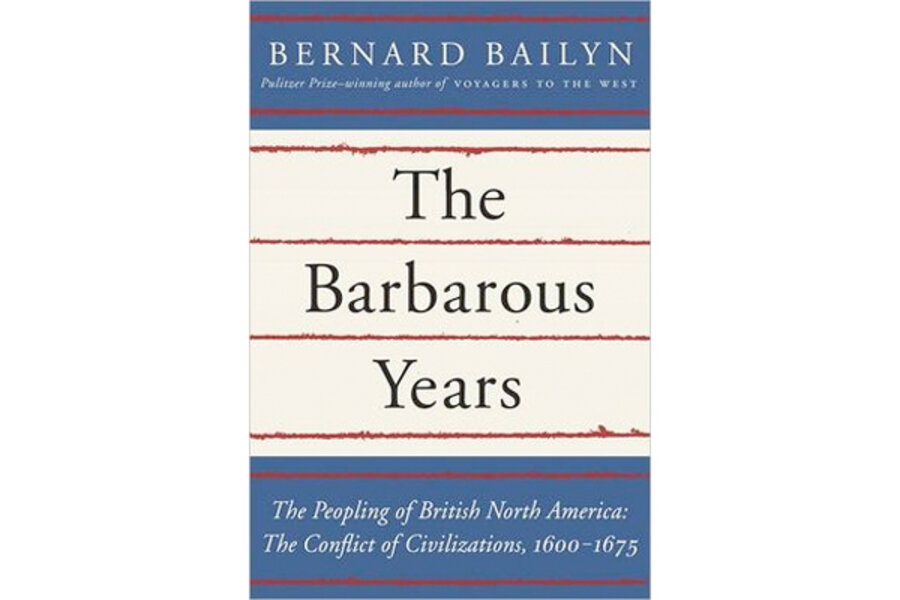The Barbarous Years
Loading...
It is tempting to call The Barbarous Years: The Conflict of Civilizations, 1600-1675, Bernard Bailyn's third volume on the "peopling" of the North American continent – he has already won a Pulitzer for an earlier volume – simply magisterial: sweeping, authoritative, commanding. But it is that and so much more. It has rare scholarly warmth, an understanding of how to be nimble with the material, to be an entertainer as well as a teacher, someone possessing both an easy familiarity with the subject combined with a responsibility – an eagerness – to keep an eye skinned for recent progress in the field, open to history's secrets and surprises, finding the good stuff and steering clear of the fashionable.
And the story here is a brutal one – approximately from Roanoke/Jamestown to the more fixed European establishment of a colonial presence on the eastern American seaboard – marked by occasional acts of dignity and guarded civility. It's all too often a narrative of people fleeing persecution, enduring insanely difficult seaward passages and raw, early months on a new land, then – and critically – trying to recreate the life they knew before, "to normalize an abnormal situation as they wrecked the normalities of the people whose world they invaded."
Bailyn starts with an overview of the native communities in the Northeast. Without being either sentimental or woo-woo, he depicts a native society well adapted to its surroundings, moving to the right places at the right seasons, sensitive to the need for space, finely attuned to the roles of reciprocity, seeking balance, touching anima, and with as many foibles as any of us. If you need to smirk, then smirk. In Bailyn's hands, the portrait convinces.
Then Bailyn covers the traceable, toxic threads that disrupted the aspirations and sensibilities as they played out between colonials and native populations, the clashing social relations, the fur trade's ruinous consequences, and the calamitous miscommunications regarding land use and ownership. And it has always been about the land, from the Pequot War to Metacom to way past these barbarous years. You range freely across some terrain, and you need a significant piece to support your way of life. Then people come who take that land from your use and threaten your survival. They may be Europeans; they may be neighboring people with whom you don't see eye to eye. But the Europeans brought with them a strange notion of property rights. "It shaped the structure of social and political relations; it was the basis of the economy; and it was 'the chief measure of wealth, prestige, and political influence.' "
Little surprise, then, that "increasingly the natives came to see that the fur traders' deepening forays into their hunting grounds and the constant expansion of farms and pastureland would drive them from their homeland and destroy the basis of their lives. They grew wary, then resentful, then hostile." Trespass? Come again? When the stakes are this high, what's not to kill for?
Bailyn elegantly draws into a big picture the kaleidoscopic swarm of individuals and communities from what is now Virginia up into Atlantic Canada – this is a story, after all, about those who came to populate these places along with its natives: adventurers, soldiers of fortune, the commercially daring; then indentured servants or those impressed from a London street for being poor or young when a trading company needed bodies; and those who came with a measure of grandeur, with family and servants, only to find the rudest of circumstances. What was the lay and geography of the early settlements? Jamestown was not just Jamestown but Lawne's Plantation and Bennett's Welcome, Archer's Hope and Jordan's Journey, and Bailyn gives readers a taste of what it was like to walk out your door in, say, Flowerdieu's Hundreds in 1624. What were the vicissitudes of Plymouth and its nearby City on the Hill? How did the tobacco economy work? What was it like to live in the crazy farrago of the New Netherlands, with its babel of northern Europeans? When and how was slavery introduced and sanctioned?
Not to forget the Protestant-versus-Catholic mayhem and the bite of early class warfare, as in Maryland: "The turmoil was in part the result of personal animosities among adventurers freed from normal social constraints... But it was also, and in large part, an expression of the resistance of the ordinary Protestant planters to the colony's Catholic establishment and to the manorial system."
What Bailyn does so well is to not only explain all the action but to pull it into a coherency, a great panoptical dazzle: what motivated people's actions, how they conducted themselves and why, what prompted intrigues, why you couldn't throw a brick in Boston in the mid-seventeenth century without hitting an enraptured zealot or oppressed schismatic, let alone an Anabaptist or a Quaker.
Gordon Wood, no slouch on the American Colonial historical landscape, has written that "Bernard Bailyn is one of America's most distinguished historians and a new book by him is always welcome." Grindingly understated, to the point of making your teeth sing. But Bailyn is now in his nineties, so let's hope that he eats the Russians' elixir yogurt or moves to that Greek island where no one dies. Another book from Bailyn would always be welcome.
Peter Lewis is the director of the American Geographical Society in New York City.








